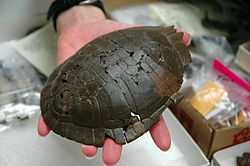Gray Fossil Site

The Gray Fossil Site is a Late Miocene-epoch assemblage of fossils located near the unincorporated town of Gray in Washington County, Northeast Tennessee, and dates from 7 to 4.5 million years BCE). The Gray Fossil Site was discovered by geologists in May 2000. They were investigating unusual clay deposits turned up during the course of a Tennessee Department of Transportation highway project to widen State Route 75 south of its intersection with Interstate 26.
State Route 75 was realigned to protect the find by order of Tennessee Governor Don Sundquist,[1] and a museum and research center at the dig operated by East Tennessee State University opened in August 2007.
The current dig at the Gray Fossil Site was determined to have been the location of a semi-circular sinkhole that once harbored a pond environment over a long period of time and is now yielding the remains of the ancient plants and animals that lived, watered, and died within the then watery sinkhole. Among the many vertebrate fossils found at the Gray Fossil Site are the those of frogs, turtles and tapirs and recovered fossil records represent finds from approximately one percent of the total area of the Gray Fossil Site that has been explored --- and future fossil recovery from the entire site is projected to continue on for one hundred years.
The Gray Fossil Site is also the world's largest tapir fossil find and is yielding new and rare discoveries such as the most complete skeleton of Teleoceras (an ancient rhinoceros) yet found in eastern North America, a new species of red panda that marks only the second record of this animal in North America (the first red panda fossils found in North America come from the state of Washington), and a newly identified species of an ancient plant-eating badger.
Gray Fossil Museum
The Gray Fossil Museum, officially known as the East Tennessee State University and General Shale Brick Natural History Museum and Visitor Center, displays some of the fossil finds from the Gray Fossil Site. Fossils on exhibit include a saber-toothed cat, short-faced bear, ground sloth, rhinoceros, alligator, camel, shovel-tusked elephant, Eurasian badger, tapirs, and a red panda. The museum opened on August 31, 2007.[2]
Fossil fauna
Fish
Osteichthyes
Amphibians
- Frogs (several taxa)
- Salamanders (several taxa)
Reptiles
- Alligators found at the site neither belong to the extinct Alligator olseni or the modern American Alligator, leading Gray Fossil Museum scholars to speculate it may be a transitional species.[3]
- Snakes (several taxa including colubrids and vipers)
- Turtles (four taxa including box turtles, snapping turtles, slider turtles, and painted turtles)
| Painted turtle fossils from Gray site | ||
 |
 |
 |
Mammals
- Shrews (several taxa)
- Moles
- Small weasel
- Arctomeles dimolodontus (prehistoric badger) NEW SPECIES
- Pristinailurus bristoli (prehistoric Red panda) NEW SPECIES
- Short-faced bears of the genus Plionarctos
- Saber-toothed cats are represented by a single part of a tooth, possibly from Machairodus.
- Shovel Tusked Elephants, or gomphotheres, are also present at the site. At the time it is unknown which species they belong to, but it is most likely that they belong to Amebelodon or a similar genus.[4]
- Teleoceras A species of hippo-like rhino common in other parts of the continent during the same time period, and lived a lifestyle similar to the modern-day hippopotamus. Several complete skeletons have been unearthed.
- Prehistoric camel, possibly a member of the genus Megatylopus.
- Tapirus polkensis (prehistoric tapir) Found in large numbers at the site, including juvenile specimens.
- Peccary (of the genus Tayassu for the Collared Peccary and the White-lipped Peccary and the genus Catagonus for the Chacoan peccary)[5]
- Rabbits
- Rodents (several taxa)
- Extinct Beaver of the genus Dipoides.[6]
- Ground Sloth (genus and species unknown)
- Three-Toed Horse (genus and species unknown)
See also
- Ashfall Fossil Beds
- Pipe Creek Sinkhole
- List of fossil sites (with link directory)
References
- ↑ "Book on Gray Fossil Site: A story millions of years in the making." Sam Watson. January 9, 2005. Johnson City Press. http://www.johnsoncitypress.com/Detail.php?Cat=TOPSTORIES&ID=42636
- ↑ http://www.grayfossilmuseum.com/?CONTEXT=art&cat=25&art=84&BISKIT=2478164064
- ↑ "Animals Discovered at the Gray Fossil Site". East Tennessee State University and General Shale Brick Natural History Museum. Retrieved 22 May 2011.
- ↑ http://www.grayfossilmuseum.com/?BISKIT=2478164064&CONTEXT=cat&cat=23
- ↑ "The Neotropical Tayassuids". International Union for Conservation of Nature. Retrieved 22 May 2011.
- ↑ http://www.johnsoncitypress.com/News/article.php?ID=73721
External links
- Gray Fossil Museum
- G. Michael Clark: Gray, Tennessee, Fossil Site
- Nick Fielder and Harry Moore: Five-Million-Year-Old Fossil Site Discovered in Washington County
- The Paleobiology Database: Gray Fossil Site Taxonomic List
- Vertebrate and pollen taxa from the Gray Fossil Site
- Welcome to the Gray Fossil Site
- Friends of Gray Fossil Site
- Abstract: The Gray Fossil Site: A Spectacular Example in Tennessee of Ancient Regolith Occurrences in Carbonate Terranes, Valley and Ridge Subprovince, Southern Appalachians U.S.A.
- YouTube: Tour of Gray Fossil Site and Museum
- Abstract: Palynology of the Gray Fossil Site, Eastern Tennessee: Its Role in Understanding the Basin Fill History (Paper presented to the 42nd Annual Meeting of the Geological Society of America, North-Central Section, 24–25 April 2008.)
- Tennessee State Web page
Coordinates: 36°23′10″N 82°29′53″W / 36.3860°N 82.4980°W